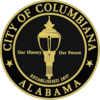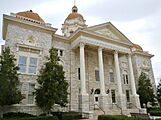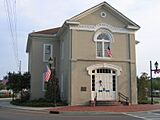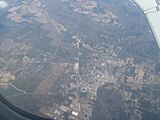Columbiana, Alabama facts for kids
Quick facts for kids
Columbiana, Alabama
|
|||||
|---|---|---|---|---|---|
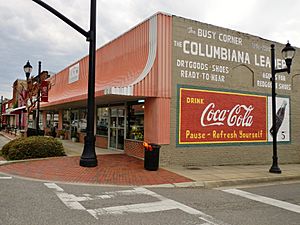
Columbiana, Alabama
|
|||||
|
|||||
| Motto(s):
"Embracing The Future, While Preserving The Past”
|
|||||
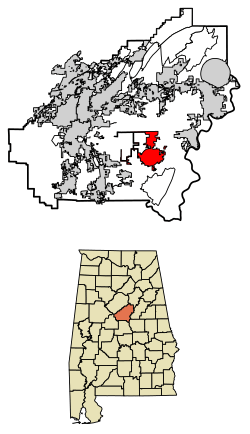
Location of Columbiana in Shelby County, Alabama.
|
|||||
| Country | United States | ||||
| State | Alabama | ||||
| County | Shelby | ||||
| Area | |||||
| • Total | 17.40 sq mi (45.07 km2) | ||||
| • Land | 17.30 sq mi (44.81 km2) | ||||
| • Water | 0.10 sq mi (0.26 km2) | ||||
| Elevation | 574 ft (175 m) | ||||
| Population
(2020)
|
|||||
| • Total | 4,462 | ||||
| • Density | 257.89/sq mi (99.57/km2) | ||||
| Time zone | UTC-6 (Central (CST)) | ||||
| • Summer (DST) | UTC-5 (CDT) | ||||
| ZIP code |
35051
|
||||
| Area code(s) | 205, 659 | ||||
| FIPS code | 01-16768 | ||||
| GNIS feature ID | 2404109 | ||||
Columbiana is a city in Alabama, United States. It is the main town, or county seat, of Shelby County. In 2020, about 4,462 people lived there.
Contents
History of Columbiana
Columbiana was chosen as the county seat for Shelby County in 1826. It won over other towns like Calera and Montevallo. To celebrate, people blew up a large pine tree with gunpowder! The sound could be heard for many miles. Later that year, the courthouse moved into an old school building in Columbiana.
The state government of Alabama officially changed the town's name to Columbiana on January 13, 1832. Columbiana became an official city on December 5, 1837. Its city limits stretched a quarter of a mile in every direction from the town square.
Courthouse Buildings
In 1854, people decided to build a bigger courthouse. It was located at the end of what is now Main Street. Over the years, more parts were added to this courthouse.
During the American Civil War, Columbiana was important for making iron. The Shelby Iron Company Railroad connected the town to the Shelby Iron Works. This company made iron for a foundry in Columbiana. The foundry made cannonballs and shells for the war. However, Union soldiers destroyed the iron works, the foundry, and the railroad on March 31, 1865.
Moving the county seat to Columbiana was not always popular. People tried many times to move it somewhere else. In 1901, a special rule was added to Alabama's state constitution. This rule, Section 41, said that Shelby County's seat could not be moved from Columbiana unless people voted for it. Shelby County is the only county in Alabama with this special rule.
To make sure Columbiana stayed the county seat, a new marble courthouse was built in 1905. It cost $300,000 and was finished in 1908. This new courthouse has been used by Shelby County for over 100 years. The older courthouse is now the Shelby County Museum and Archives.
Columbiana Today
Today, Columbiana is home to many important offices. These include the Shelby County Board of Education and the Shelby County Sheriff's Office. It also has the Shelby County Jail and the Harrison Regional Library.
Every year, Columbiana celebrates Liberty Day on the last weekend in June. This celebration started in 1986 to honor the 100th birthday of the Statue of Liberty. The current mayor of Columbiana is David Mitchell.
Geography
Columbiana is located in the southeastern part of Shelby County. Alabama State Route 25 runs near the downtown area. This road goes northeast to Wilsonville, which is about 9 miles away. It also goes southwest to Calera, about 11 miles away.
Population Information
The population of Columbiana has changed over the years. Here's how many people have lived there during different census counts:
| Historical population | |||
|---|---|---|---|
| Census | Pop. | %± | |
| 1880 | 496 | — | |
| 1890 | 654 | 31.9% | |
| 1900 | 1,075 | 64.4% | |
| 1910 | 1,079 | 0.4% | |
| 1920 | 1,073 | −0.6% | |
| 1930 | 1,180 | 10.0% | |
| 1940 | 1,197 | 1.4% | |
| 1950 | 1,761 | 47.1% | |
| 1960 | 2,264 | 28.6% | |
| 1970 | 2,248 | −0.7% | |
| 1980 | 2,655 | 18.1% | |
| 1990 | 2,968 | 11.8% | |
| 2000 | 3,316 | 11.7% | |
| 2010 | 4,197 | 26.6% | |
| 2020 | 4,462 | 6.3% | |
| U.S. Decennial Census | |||
2010 Census Details
In 2010, there were 4,197 people living in Columbiana. They lived in 1,303 homes. About 28% of these homes had children under 18. About 47% were married couples.
Most people in Columbiana were White (71.3%). About 25.1% were Black or African American. A small number of people were from other racial backgrounds. About 3% of the population was Hispanic or Latino.
2020 Census Details
In 2020, the population of Columbiana was 4,462 people. There were 1,641 households and 851 families in the city.
| Race | Number | Percent |
|---|---|---|
| White (not Hispanic) | 3,139 | 70.35% |
| Black or African American (not Hispanic) | 1,003 | 22.48% |
| Native American | 3 | 0.07% |
| Asian | 7 | 0.16% |
| Other/Mixed | 175 | 3.92% |
| Hispanic or Latino | 135 | 3.03% |
Schools in Columbiana
The Shelby County Schools system runs the public schools in Columbiana.
- Elvin Hill Elementary School teaches students from kindergarten to fifth grade.
- Columbiana Middle School is for students in sixth through eighth grade.
- Shelby County High School serves students from ninth to twelfth grade. Their sports teams are called the Shelby County Wildcats. Their school colors are maroon and white.
- Shelby County School of Technology is a special school for learning job skills.
- Cornerstone Christian School is a private school for students from pre-kindergarten to twelfth grade.
Famous People from Columbiana
Some notable people have connections to Columbiana:
- Robert J. Bentley (born 1943) was the Governor of Alabama from 2011 to 2017. A Governor is the leader of a state.
- Leven H. Ellis (1881–1968) was the Lieutenant Governor of Alabama from 1943 to 1947. A Lieutenant Governor is like a vice-leader of a state.
- J. Frank Norris (1877–1952) was an important leader in the Baptist church. He lived in Columbiana when he was young.
- E. B. Teague (1820–1902) was a well-known Baptist preacher.
- Mary Ware was a writer who wrote poems and stories.
Images for kids
-
The Shelby County Courthouse in Columbiana.
See also
 In Spanish: Columbiana (Alabama) para niños
In Spanish: Columbiana (Alabama) para niños



